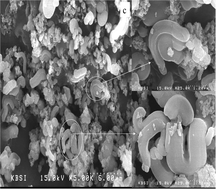This paper describes a new method for incorporating various amounts of ruthenium species (Ru) into hybrid periodic mesoporous organosilicas (HPMO). The effects that the Si : Ru ratio has on the Ru-containing HPMO materials (Ru-HPMO) were determined by powder X-ray diffraction (XRD), N2 sorption, transmission electron microscopy (TEM), scanning electron microscopy (SEM), X-ray photoelectron spectroscopy (XPS), solid state 29Si and 13C nuclear magnetic resonance (NMR) spectroscopy, Fourier transform infrared spectroscopy (FT-IR), and thermogravimetric analysis (TGA). The Ru-HPMO materials exhibited type-H4 hysteresis loops at p/po ratios between 0.45 and 1 and contained some structural defects amid their nanochannels. The hysteresis loop is associated with pore blocking in the mesostructures, which we correlated with the Ru content. The presence of Ru and Si–C bonds in the Ru-HPMOs was confirmed by XPS and NMR spectroscopy, respectively. The analyses also indicated the presence of Ru species within the pores of the host material. Controlled loading of Ru was possible up to a maximum of 25 wt.%. The well-defined morphologies were produced as a result of a combination of disclination and dislocation defects toward the growth of liquid crystals. Moreover, TEM images suggest that the resulting uniform mesoporous structure of Ru-HPMO was maintained even at high Ru loadings.

You have access to this article
 Please wait while we load your content...
Something went wrong. Try again?
Please wait while we load your content...
Something went wrong. Try again?


 Please wait while we load your content...
Please wait while we load your content...